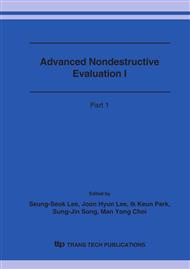p.314
p.318
p.322
p.328
p.332
p.336
p.340
p.344
p.348
Evaluation of Residual and Actual Stress Levels of Steel Columns in Existing Building Structures due to Working Loads
Abstract:
A wide variety of residual stress measurement methods can be used to measure the axial stress in a column. One of the most widely used techniques for measuring residual stress is slotting method since it is relatively simple and cost-effective to implement at vertical columns in field. However, the slotting method is considered to be semi-destructive or destructive method depending on the amount of material to be removed. Therefore, in this paper, optimal depth of slots for measuring actual stress is presented to minimize the amount of material to be removed. Finite element method is used to estimate the minimum depth of the slot in H-shaped steel column. By performing actual saw cutting, optimality of the simulated depth of the slot is investigated.
Info:
Periodical:
Pages:
332-335
Citation:
Online since:
October 2006
Authors:
Price:
Сopyright:
© 2006 Trans Tech Publications Ltd. All Rights Reserved
Share:
Citation:


